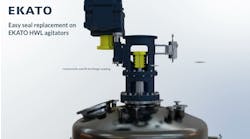At 2:09 p.m., February 16, 2007, a cracked elbow in bypassed piping at the Valero-McKee refinery in Sunray, Texas, leaked propane. This leak triggered a series of events around a de-asphalting extraction column that, although serious, could have been much worse. As it was, three workers were severely burned. The U.S. Chemical Safety Board (CSB) investigated and concluded that a foreign object had probably lodged in the block valve that was supposed to isolate the dead-leg section of piping. Water, an impurity in the feed, accumulated in the elbow. In early February, temperatures dropped to well below zero — the water turned to ice and expanded, cracking the elbow. Then, when temperatures rose and the ice melted, propane escaped. [pullquote] It's interesting to speculate on who opened the block valve and why. The dead leg was properly isolated for many years. This question wasn't addressed in the CSB video: "Fire from Ice," http://www.chemsafety.gov/.The CSB found the dead-leg piping originally was designed to provide propane mixed with pitch to the top of the extraction column. In the early 1990s the process was changed, presumably after a hazards and operability (HAZOP) review.This accident highlights a common problem in our industry. Plants sideline equipment and processes for weeks, months or even years. The units are isolated, or perhaps not, and allowed to rust. I've seen this at refineries, chemical and food plants, and even in municipal water-treatment facilities. This approach euphemistically is called, "abandon-in-place." Regardless of what you call it, it's a poor engineering practice.At Anheuser-Busch, we abandoned piping because of asbestos insulation; it was cheaper to leave it in place than to remove the asbestos. In the end we took out the pipe because block valves leaked, causing product contamination. We had a similar situation when I worked at Ralston Purina.Sometimes, abandon-in-place can involve electrical service. Derelict switchgear, it seems to me, prompts a great many so-called ground faults. At the isomerization unit of a refinery such a fault caused a power blip. As a process engineer at a chemical plant I saw a similar problem affect our distributed control system and backup programmable logic controller. These incidents, really near misses, are more serious than ones that spoil product.When I was at Anheuser-Busch we lost several batches of yeast because water poured down inside a rusty neglected starter box, causing a ground-fault trip. If the electrician had pulled the wires as instructed, this never would have occurred. So how can these hazards be avoided?For aboveground piping, the solution is simple. Install complete isolation: a blind flange is better than a block valve; a weld cap is best. For underground piping, costs significantly increase — but digging is a lot cheaper than risking an accident or a visit from the EPA. You have more to worry about than leaks.Dealing with wiring can pose greater challenges, especially at an older site. Drawings may not be current or accurate; this is especially true for one-line diagrams.Regardless of the nature of the abandoned equipment, a management of change committee should review its disposition. Inspect the equipment after it's been isolated to assure compliance with the wishes of the committee. Don't forget the drawings! Electrical and mechanical diagrams should reflect current plant operation.While much of the responsibility falls on operating staff, design engineers aren't completely off the hook. They should allow for potential situations that require bypassing a line. Ideally, design for double-block-and-bleed (DB&B). This is familiar to most engineers from the food-and-drug side of our business but new to refineries. DB&B enables safe removal of equipment such as pressure gauges. If DB&Bs had been used instead of a single block valve, Valero may have avoided its accident.Now, let's move on to "temporarily" bypassed equipment.Some engineers expect such equipment to perform like new. Don't be fooled. Take special precautions to avoid problems. Maintain records of the equipment. Completely tear down rotary equipment — even if properly stored with correct lubricant (make sure the storage lubricant is compatible with the lubricant required when the equipment is running) — if left standing for more than a month. Check and clean static equipment such as tanks. Replace all relief equipment. Inspect high maintenance items. And, of course, pressure-test the bypassed process. As with most start-ups, a thorough checklist can prevent anything from being overlooked. Modify the checklist to include what-if provisions. This tool will provide inexperienced engineers with some insight into solving problems.With good judgment and caution, you can avoid accidents involving bypassed equipment.


